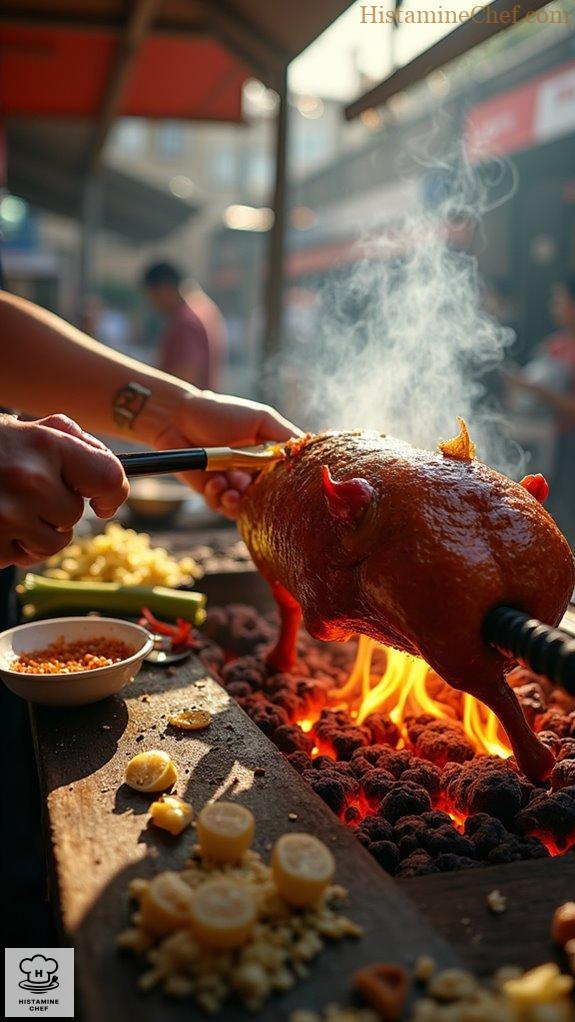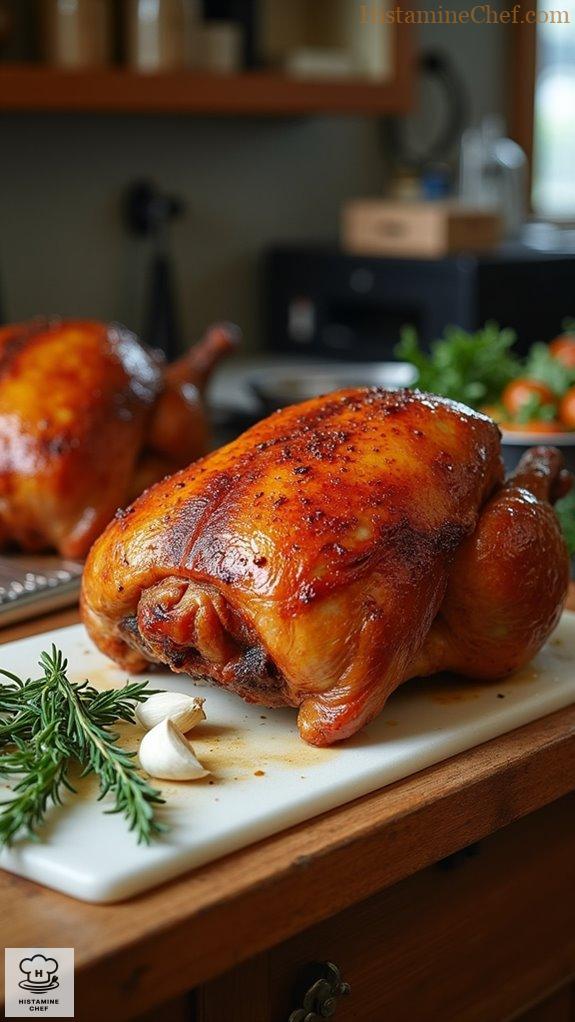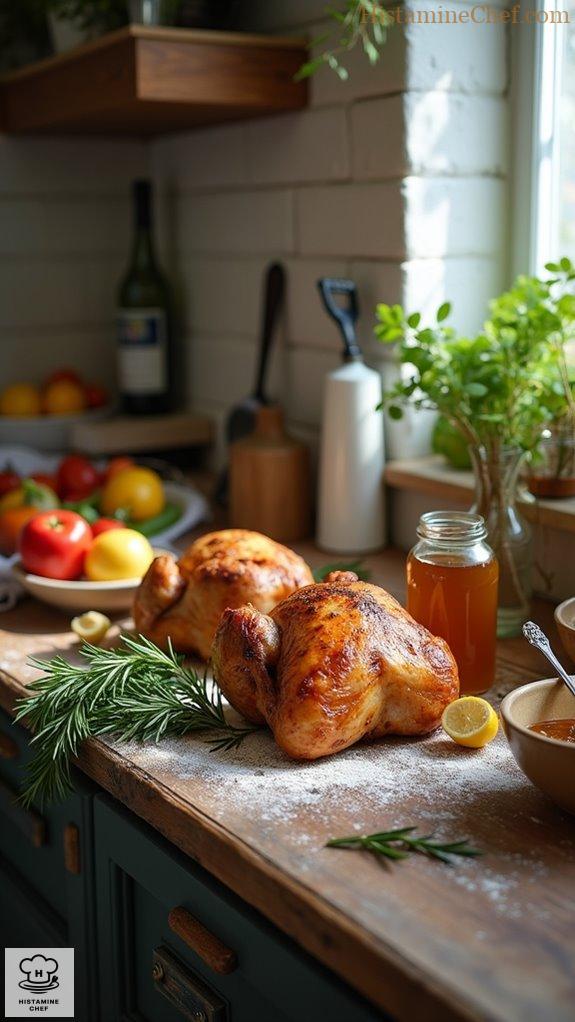Want to savor Filipino lechon without the histamine headache? I’ve got you covered! Start by seasoning a 15-20 lb pork shoulder with salt and fresh herbs, stuffing it with garlic for that mouthwatering flavor. Skip the processed sauces; opt for homemade coconut vinegar basting to keep it fresh. Roast it slowly at 180°C, and watch as that golden-brown skin crisps up beautifully. Curious how to make it even more delightful? Stick around for the secrets!
Cultural Hub of Southeast Asia

The street food culture in the Philippines, particularly in urban centers like Manila, is a vibrant expression of the country’s culinary heritage. Filipino street food has its roots in the pre-colonial era, where local tribes would cook food over open flames and trade it in bustling marketplaces. This culinary tradition has evolved, incorporating influences from Spanish, Chinese, and American cuisines, making it a reflection of the Philippines’ rich and diverse history.
Street vendors serve a variety of dishes, from skewered meats like chicken or pork adobo to the popular lechon, a whole roasted pig, which symbolizes celebration and community. The casual, open-air atmosphere of street food markets, filled with the enticing aromas of grilled and fried delicacies, provides a unique dining experience.
These vendors often work late into the night, catering to night owls and locals looking for a quick and delicious meal. The accessibility and affordability of street food make it a staple for many Filipinos, contributing to its status as an integral part of the country’s social fabric, where communities gather to enjoy scrumptious bites and share stories, embodying the Filipino spirit of hospitality and togetherness.
Charcoal Grilling on Spitted Rotisserie

Street vendors cook Filipino Lechon by skewering a whole pig on a spitted rotisserie and slow-roasting it over charcoal.
The cooking process typically involves marinating the pig in a mixture of garlic, lemongrass, and spices for at least several hours to infuse flavor.
Once marinated, the pig is mounted onto a rotisserie frame and placed over a charcoal grill, where it’s turned continuously to guarantee even cooking and achieve that signature crispy skin.
Vendors often use a special basting marinade made from sugar, soy sauce, and vinegar to enhance the flavor and color of the skin as it cooks, creating a deliciously crispy exterior while the meat remains tender and juicy inside.
Ingredients Needed:
- 1 whole pig (around 20-30 kg)
- 1 cup soy sauce
- 1 cup vinegar
- 1 cup water
- 1 cup sugar
- 1 bunch lemongrass (crushed)
- 10 cloves garlic (minced)
- Salt to taste
Cooking Steps:
- Marinate the pig overnight.
- Skewer the pig onto the rotisserie.
- Prepare charcoal for grilling.
- Place pig over the charcoal grill.
- Continuously rotate the pig while cooking.
- Baste with marinade for flavor.
- Cook until skin is crispy.
- Serve hot and sliced.
Home Rotisserie Cooking Method

To make Filipino Lechon at home using a rotisserie, start with a whole pig or piglet, ideally around 15-20 lbs. You’ll need a rotisserie setup, either a dedicated rotisserie oven or a grill with a rotisserie attachment.
Season the pig with salt and your choice of allowed herbs and spices, avoiding any that are restricted. Stuff the cavity with garlic and herbs, ensuring even cooking.
Secure the pig on the spit and cook over indirect heat, turning slowly, for several hours until the skin is golden and crispy. Baste periodically to keep the meat moist, and aim for a final internal temperature of 160°F for safety.
Cooking Steps Changed at Home:
- Use a smaller pig or pork shoulder
- Season with allowed herbs and spices
- Avoid fermented or high-histamine sauces
- Secure meat on the rotisserie
- Cook over indirect heat
- Baste with oil or allowed broth
- Check internal temperature before serving
Low Histamine Variation of Lechon

Histamine intolerance can notably affect one’s ability to enjoy street food, as many popular vendors use high-histamine ingredients and preservation techniques.
Most street foods are made with processed meats, sauces, and condiments, which tend to contain liberators or restricted items on the SIGHI list. Consequently, individuals with histamine intolerance often find themselves unable to partake in these culinary delights without risking adverse reactions.
Eating street food poses risks for those with histamine intolerance due to the high likelihood of exposure to restricted ingredients.
Many street foods incorporate items such as tinned or cured meats, fermented sauces, and preserved vegetables, all of which are known to be high in histamine or act as liberators. The SIGHI list highlights these ingredients, emphasizing the need for careful consideration.
Individuals with this intolerance must be vigilant to prevent potential discomfort or food-related illnesses. Utilizing smart cooking techniques can greatly assist in creating low histamine versions of beloved recipes.
Low Histamine Variation of Lechon Instructions:
- Use fresh, pure chicken or duck instead of any processed meats.
- Avoid marinating with soy sauce; opt for apple vinegar instead.
- Season with allowed herbs, like rosemary, omitting restricted spices and salts.
- Ascertain skin isn’t preserved or cured; use fresh skin for crispy results.
- Cook in extra virgin olive oil or coconut oil; no other oils allowed.
- Avoid dried or canned vegetables; choose fresh alternatives exclusively.
- Refrain from using any pre-made sauces; sauce must be homemade and safe.
- Avoid additives like commercial sweeteners; use sugar or honey if necessary.
- Prepare the dish immediately; don’t store leftovers to prevent histamine buildup.
- Serve with allowed side veggies or rice instead of pickled or tinned variety.
Video Summary
Lechon is a celebrated Filipino dish known for its crispy skin and tender, flavorful meat. This dish dates back to pre-colonial Philippines, symbolizing heritage and celebration. In this video, we’ll explore both the authentic street version and a home-friendly low histamine version of Lechon.
Street vendors prepare Lechon by marinating a whole pig. They use a mixture of garlic, soy sauce, vinegar, and spices. Then, they stuff the pig’s cavity with lemongrass and garlic.
Next, they skewer it on a large iron rod. Now, the pig is slowly roasted over charcoal for several hours. This process allows the skin to get crispy and the meat to absorb all the flavors. The sight and smell as it roasts is simply irresistible.
For the home low histamine version, start by using a small pork shoulder instead. Skip the soy sauce and use coconut vinegar for marinating. Replace the spices with safe herbs like salt and garlic. Instead of lemongrass, try using homemade herb sprigs for stuffing.
Next, roast the pork shoulder in an oven preheated to 180 degrees Celsius. Use a roasting pan to catch any drippings. Roast it for about two to three hours. Check the internal temperature reaches 70 degrees Celsius for doneness.
The result should show golden-brown skin and juicy meat. The flavors will be rich but gentle on the stomach. Click the link in the description for the full recipe.


Leave a Reply